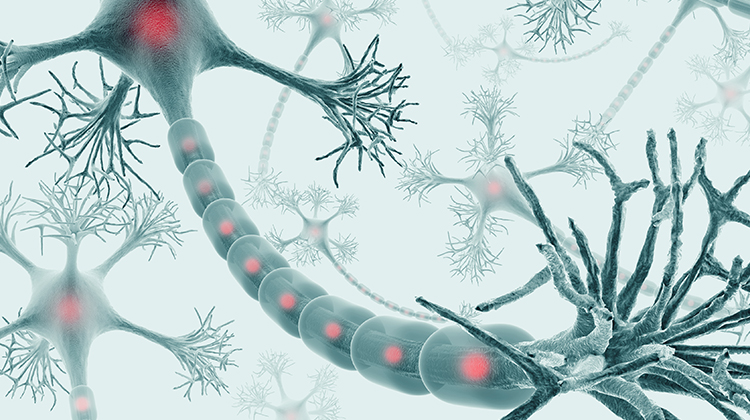 Expert's opinion
Expert's opinion
Expert's opinion
The article is a subjective view on this topic written by writers specializing in medical writing.
It may reflect on a personal journey surrounding struggles with an illness or medical condition, involve product comparisons, diet considerations, or other health-related opinions.
Although the view is entirely that of the writer, it is based on academic experiences and scientific research they have conducted; it is fact-checked by a team of degreed medical experts, and validated by sources attached to the article.
The numbers in parenthesis (1,2,3) will take you to clickable links to related scientific papers.
Somatic Nervous System – Definition, Function & Examples

To understand the somatic nervous system, let’s run a little experiment. First, raise your hand. Now, lower it back down. You have just witnessed the somatic nervous system in action.
Your brain, more technically the central nervous system, is where thinking takes place. However, it’s the somatic nervous system that allows you to turn thought into motion, as well as allowing you to sense your environment.
What is the Somatic Nervous System?
The somatic nervous system (SNS) consists primarily of 31 pairs of spinal nerves and 12 pairs of cranial nerves. It connects the central nervous system (CNS), your brain, and spinal cord, to the rest of your body, communicating sensory and motor signals.
To understand what that means a little more clearly, imagine a cold glass of water. If you touch it, sensory neurons in your fingers pick up that sensation and transmit it to your brain. You decide to pick it up, sending another signal down to your hand.
That signal gets transmitted to the skeletal muscles in your arm and hand, the muscles that you use for voluntary and reflex movements. All of those signals are traveling through the somatic nervous system.[1]
As we’ve mentioned, signals are processed in the CNS[2], the brain. In addition, 12 pairs of nerves that are part of the SNS run to the ears, eyes, and mouth. Those pairs are called:
- Olfactory nerves
- Optic nerve
- Oculomotor nerves
- Trochlear nerves
- Trigeminal
- Abducens
- Facial
- Vestibulocochlear
- Glossopharyngeal
- Vagus
- Spinal accessory
- Hypoglossal
Most of the rest of the SNS, however, is part of the peripheral nervous system[3].
Peripheral nervous system
Most of the nerves that aren’t part of the brain and spinal cord belong to the peripheral nervous system[4]. Most of your organs, including your heart and lungs, are connected by the autonomic peripheral nervous system. They don’t get involved in the SNS.
All the nerves in the rest of the body do. 31 pairs of nerves run from your spinal cord and down your spinal column. One nerve from the pair transmits signals from sensory organs up to the brain, while the other sends signals down to motor neurons. From the spine, nerves branch out to your arms and legs. There are:
- 8 cervical nerves
- 12 thoracic nerves
- 5 lumbar nerves
- 5 sacral nerves
- And 1 coccygeal nerve
Nerves that transmit signals to the brain are called afferent nerves. Pain relievers and medications for nerve pain work partly by stopping those signals. Those that transmit signals to motor neurons are called efferent nerves.
It takes only a fraction of a second for signals to travel back and forth from the brain. However, we can actually respond even faster, as sometimes signals travel right from sensory neurons to motor neurons, causing a muscle contraction. This automatic response is better known as a reflex.
Voluntary vs Reflex Actions
Your body can be separated in broad strokes between the aspects you can consciously control and those you cannot. An example of something you can’t consciously control might be your digestive system. Most of what the somatic nervous system does, however, is all about voluntary actions, things you decide to do.
In some circumstances, though, your SNS will act automatically. It’s generally the same nerves and neurons involved. However, sometimes something sudden or serious has happened, so there needs to be a quick reaction.
We’ve all experienced this, for example when touching a hot stove accidentally. You reflexively flinch away from the pain and heat that might damage your skin. In the time it takes for a signal to make it to your brain and then come back, you might have quite a serious burn.
In order to react more quickly, reflexes[5] take a shortcut. Rather than going to the brain, the signal makes a shorter trip to your spinal column. There, the signal goes right from the afferent nerve to the efferent nerve, from sense to motion without stopping to think. This process is called the reflex arc.
Another classic example is when the doctor taps your knee so that your leg jumps. The sensory neuron connects right to the motor neuron, so the reflex happens as quickly as possible.
Nerves and Neurons
One nerve[6] is made up of millions of specialized cells called neurons, all they do is pass electrical signals from one to the next. Neurons have all the same things a cell normally does. It has a nucleus, mitochondria, and so forth. However, a neuron also has some unique equipment.
A neuron looks sort of like a balloon at the end of a string. The balloon is the cell’s nucleus. Coming off the nucleus, like dog hair stuck to the plastic of the balloon with static electricity, are fine little branches called dendrites.
Dendrites get tangled up with other neurons and are used to receive signals from further up the line. The long string dangling down from the balloon is something called an axon. Once the neuron has received a signal through the dendrites, it flows down the axon, where it gets passed to the next neuron.
Strings of neurons come together to form fibers. Bundles of those fibers are what makeup nerves.
The Autonomic Nervous System
The somatic nervous system covers voluntary actions and reflexes. However, there are a lot of things going on in our body that need to be regulated, but that you can’t control consciously. For example, you can’t speed up your metabolism just by thinking about it. No matter how hard you concentrate, you probably can’t change the balance of hormones in your body. All of those processes that you’re not conscious of form the autonomic nervous system (ANS).
It’s made up of neurons just like the somatic nervous system, but it reacts and operates differently. Rather than moving around and sensing things, the autonomic nervous system[7] is mostly concerned with homeostasis[8].
To call homeostasis a balance between the different bodily systems would be a little simplistic, but that’s sort of the idea. In order to be healthy and live our lives, everything in our body has to work together smoothly. However, the balance point is constantly shifting as we react to our environment. Homeostasis isn’t one thing, therefore, but a range in which you can operate healthily.
Sympathetic and Parasympathetic
The ANS is broadly divided into two parts, called the sympathetic and parasympathetic[9] nervous systems. The sympathetic nervous controls things like:
- Heart rate
- Perspiration
- Pupil dilation
- Blood vessel constriction or dilation
- Increased metabolism
That’s just a shortlist. The sympathetic nervous system is also associated with the flight-or-fight response. Danger causes your heart rate to increase, your lungs open up, and a bunch of other changes, all regulated by the ANS.
The parasympathetic nervous system is further divided into restorative and defensive systems. The defensive system is also associated with the fight-or-flight reaction, reducing function when the sympathetic system starts revving things up.
The restorative system takes over once the danger is past. When your heart rate slows down, it’s because the sympathetic system is chilling out, while the restorative system takes over to clean up after the red alert.
Conclusion
The nervous system is probably the most complicated part of the body. There is a lot more to it than whatever is taking up space in your skull. It touches every part of your body and it’s what sets everything in motion. The part that literally gets you moving, however, is the somatic nervous system.
+ 9 sources
Health Canal avoids using tertiary references. We have strict sourcing guidelines and rely on peer-reviewed studies, academic researches from medical associations and institutions. To ensure the accuracy of articles in Health Canal, you can read more about the editorial process here
- Akinrodoye, M.A. and Forshing Lui (2020). Neuroanatomy, Somatic Nervous System. [online] Nih.gov. Available at: https://www.ncbi.nlm.nih.gov/books/NBK556027/ [Accessed 21 Jul. 2021].
- Medlineplus.gov. (2021). Central nervous system and peripheral nervous system: MedlinePlus Medical Encyclopedia Image. [online] Available at: https://medlineplus.gov/ency/imagepages/8679.htm [Accessed 21 Jul. 2021].
- Merck Manuals (2021). Synapse. [online] Merck Manuals Consumer Version. Available at: https://www.merckmanuals.com/home/brain,-spinal-cord,-and-nerve-disorders/peripheral-nerve-and-related-disorders/overview-of-the-peripheral-nervous-system [Accessed 21 Jul. 2021].
- Uq.edu.au. (2018). Peripheral nervous system. [online] Available at: https://qbi.uq.edu.au/brain/brain-anatomy/peripheral-nervous-system [Accessed 21 Jul. 2021].
- Frontiers for Young Minds. (2017). When Kicking the Doctor Is Good—A Simple Reflex. [online] Available at: https://kids.frontiersin.org/articles/10.3389/frym.2017.00010 [Accessed 21 Jul. 2021].
- Purves, D., Augustine, G.J., Fitzpatrick, D., Katz, L.C., Anthony-Samuel LaMantia, McNamara, J.O. and S Mark Williams (2021). Nerve Cells. [online] Nih.gov. Available at: https://www.ncbi.nlm.nih.gov/books/NBK11103/ [Accessed 21 Jul. 2021].
- LeBouef, T., Yaker, Z. and Whited, L. (2021). Physiology, Autonomic Nervous System. [online] Nih.gov. Available at: https://www.ncbi.nlm.nih.gov/books/NBK538516/ [Accessed 21 Jul. 2021].
- homeostasis | Definition, Examples, & Facts | Britannica. (2021). In: Encyclopædia Britannica. [online] Available at: https://www.britannica.com/science/homeostasis [Accessed 21 Jul. 2021].
- Kozlowska, K., Scher, S. and Helgeland, H. (2020). The Autonomic Nervous System and Functional Somatic Symptoms. Functional Somatic Symptoms in Children and Adolescents, [online] pp.119–136. Available at: https://link.springer.com/chapter/10.1007/978-3-030-46184-3_6 [Accessed 21 Jul. 2021].



